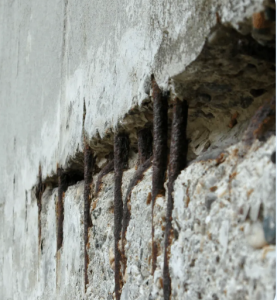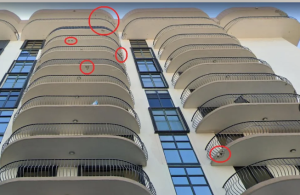Concrete Spalling Florida

Protect Your Structure Before It Fails
Concrete Spalling Florida is one of the most common—and dangerous—structural issues facing property owners in coastal and humid zones. Across Tampa, St. Petersburg, Clearwater, Sarasota, Orlando, Miami, and other Florida cities, unchecked deterioration can threaten homes, condo towers, seawalls, parking structures, and marine foundations.
What Is Concrete Spalling?
Concrete spalling begins when the reinforcing steel (rebar) inside concrete starts to corrode. Because concrete is naturally porous, water and oxygen migrate inward and trigger a chemical reaction that forms iron oxide (rust). As corrosion progresses, the steel expands and exerts pressure on the surrounding concrete matrix.
Technical note: Once steel begins to oxidize, it can expand up to 16× its original diameter. This expansion produces intense tensile stresses in the cover concrete, causing cracking, delamination, and ultimately spalling—where flakes or chunks detach from ceilings, balconies, columns, beams, or slabs.
Spalling is more than cosmetic—it is a structural warning sign. After the cover cracks, air and moisture have a direct pathway to the steel, accelerating corrosion, escalating repair costs, and shortening the service life of the structure.
Concrete Corrosion by the Numbers

Why Concrete Spalling Is So Common in Florida
- Salt air & saltwater exposure: Chlorides break down the steel’s passive film, accelerating corrosion.
- High humidity & rainfall: Increases the time concrete stays saturated, boosting oxygen and ion transport.
- High water table: Promotes vapor drive and slab wetting from below when no vapor barrier is present.
- Hurricanes & coastal storms: Force salt-laden water deeper into porous concrete.
Common Florida Trouble Spots
- Condo balconies and structural floor slabs
- Parking garages and podium decks
- Structural columns, beams, and load-bearing walls
- Seawalls, piers, and marine foundations
- Driveways, walkways, and pool decks (especially without vapor barriers)
Related service: Seawall & Marine Foundation Repair
Signs of Concrete Spalling

- Flaking, scaling, or crumbling surfaces
- Cracks and hollow-sounding areas (delamination)
- Rust “bleed-through” stains
- Exposed or rusting rebar
- White efflorescence deposits
Learn more about moisture indicators on our Efflorescence & Slab Moisture page.
Professional Concrete Spalling Repair in Florida
At Foundation Waterproofing 101, remediation is engineer-designed and led by Civil Engineer Ken Sands, P.E., bringing 21+ years of forensic foundation and concrete repair experience. We solve both the visible symptoms and the root moisture/corrosion drivers.
Our Engineer-Designed Repair Process
- Assessment & sounding: Mechanical/electronic sounding to locate hidden voids and delaminations; targeted chloride and cover-depth checks.
- Selective demolition: Remove all unsound and contaminated concrete to sound substrate with defined repair perimeters.
- Steel treatment: Clean, replace, or supplement rebar; apply corrosion-inhibiting coatings or cathodic protection elements where specified.
- Structural patching: Place engineered repair mortars or epoxy systems matched for strength, modulus, and thermal compatibility.
- Waterproofing & vapor control: Apply membranes, sealers, and/or install vapor barriers to block future moisture and chloride ingress.
Explore related protections on our Structural Waterproofing page.
Why Choose Us
We are Florida’s #1 waterproofing and hydraulic engineering firm. Our integrated structural engineering, civil design, and waterproofing expertise delivers durable, code-compliant results that restore safety and value—rather than temporary patches that fail.
Schedule Your Free Inspection
If you’ve noticed flaking concrete, rust stains, or white residue, don’t wait. Concrete spalling only accelerates with time.
???? Call: 813-614-4830
???? Serving: Tampa, Clearwater, St. Petersburg, Sarasota, Orlando, Miami, and coastal communities statewide.
Helpful Links
- Structural Waterproofing Solutions
- Efflorescence & Slab Moisture Solutions
- Seawall & Marine Foundation Repair
- Forensic Structural Inspection
Concrete Spalling in Florida — Why Early Action Saves Money
Concrete spalling is more than a cosmetic issue — it’s an early sign that the reinforcing steel inside your concrete has begun to corrode and expand. In Florida’s coastal and humid environment, chloride-rich salt air, heavy rainfall, and high water tables accelerate corrosion and can shorten the life of structural slabs, balconies, seawalls, and parking decks. Once cracking begins, moisture and oxygen travel directly to the rebar, speeding up damage and turning a small repair into a major rebuild.
At Foundation Waterproofing 101, our inspections are led by licensed engineers who specialize in water intrusion and structural durability. We use non-destructive testing, chloride analysis, and cover-depth mapping to understand exactly how far corrosion has advanced. From there, we design a repair plan that addresses both the visible spalling and the underlying moisture and chloride pathways. Our goal is to stop corrosion, restore strength, and prevent repeat failures.
Typical remediation may include selective concrete removal to sound material, cleaning or replacing rebar, applying corrosion-inhibiting coatings, and rebuilding with engineered repair mortars. We pair these repairs with waterproofing or vapor barriers where appropriate to keep new chlorides and moisture out. This approach extends the life of concrete structures by decades and avoids the steep cost of structural replacement.
Whether you manage a condo tower, marine structure, parking garage, or residential property, early evaluation is critical. If you see flaking, rust staining, or hollow-sounding concrete, schedule a professional inspection now. Request a concrete spalling assessment or call 813-614-4830 to protect your structure before deterioration accelerates.
Concrete Spalling Florida — FAQs
How fast can rebar corrosion lead to spalling in Florida?
What are the first warning signs of concrete spalling?
Early signs include hairline cracks, rust-colored stains, hollow or drummy sounds when tapping the concrete, and small flakes or chips near edges and corners. These are indicators that the reinforcing steel is already rusting.
Is spalling just cosmetic or does it weaken the structure?
Spalling is a structural warning sign. As steel expands, it pushes on the surrounding concrete and reduces its strength. Left untreated, spalling can compromise slabs, beams, balconies, and seawalls, leading to costly structural failures.
Can spalled concrete simply be patched over?
No. Patching over corroded steel without removing damaged material and treating the rebar will lead to continued corrosion and failure of the repair. Proper remediation requires removing unsound concrete, cleaning or replacing steel, and using engineered repair mortars.
Who performs the inspection and repair design?
All inspections and repair designs at Foundation Waterproofing 101 are engineer-led — not sales-based. Jeff Earl, CEO and water hydraulics engineer, oversees each assessment to ensure your solution is scientifically designed and long-lasting.
How can future spalling be prevented after repairs?
Prevention focuses on controlling moisture and chloride intrusion. After structural repairs, we recommend applying waterproof coatings or membranes, improving drainage, and using proper vapor barriers to keep steel protected.
